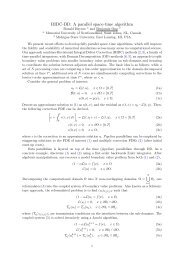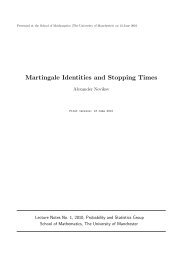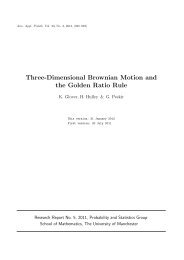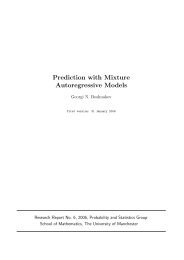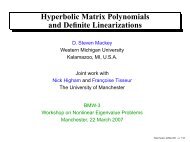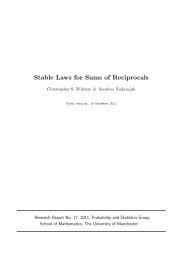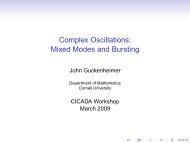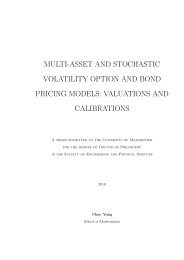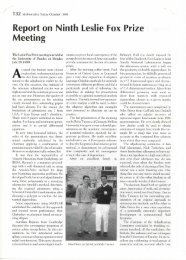Local Behaviour of First Passage Probabilities - MIMS - The ...
Local Behaviour of First Passage Probabilities - MIMS - The ...
Local Behaviour of First Passage Probabilities - MIMS - The ...
Create successful ePaper yourself
Turn your PDF publications into a flip-book with our unique Google optimized e-Paper software.
(ii) Since the probability <strong>of</strong> the limiting conditioning event is positive, thisfollows from the weak convergence <strong>of</strong> X (n) to Y:Until further notice we assume we are in the lattice case, and x; y; z willbe assumed to take non-negative integer values only.We will write1X1Xg(m; y) = P (T n = m; H n = y) and g(y) = P (H n = y)n=0for the bivariate renewal mass function <strong>of</strong> ( ; H) and the renewal mass function<strong>of</strong> H respectively: Our pro<strong>of</strong>s are based on the following obvious representation:P (T x = n + 1) = X y0P (T x > n; S n = x y)F (y); x 0; n > 0; (16)n=0To exploit this we need good estimates <strong>of</strong> P (T x > n; S n > x y); and we derivethese from the formulaXy^xnXP (S n = x y; T x > n) = g(r; x z)g (n r; y z); (17)z=0 r=0where g denotes the bivariate mass function in the weak downgoing ladderprocess <strong>of</strong> S: Formula (17), which extends a result originally due to Spitzer,follows by decomposing the event on the LHS according to the time and position<strong>of</strong> the maximum, and using the well-known duality result:g (m; u) = P (S m = u; > m): (18)(See Lemma 2.1 in [4]). Of course we also haveg(m; u) = P (S m = u; > m); (19)and our main tool in estimating P (S n = x y; T x > n) will be the following estimatesfor g and g : <strong>The</strong> results for g are established in [21], where they are statedas estimates for the conditional probability P (S m = uj > m): (See <strong>The</strong>orems5 and 6 in [21].) <strong>The</strong> results for g can be derived by applying those resultsto S; and then using the calculation given on page 100 <strong>of</strong> [3] to deduce theresult for the weak ladder process. Recall that V (x) = P 1 P xm=0 u=0g (m; u),and write f for the density <strong>of</strong> Y 1 ; where Y is the limiting stable process. Alsop and ~p stand for the densities <strong>of</strong> Z (1)1 and Z ~ (1)1 ; the stable meanders <strong>of</strong> length1 at time 1 corresponding to Y and Y:Lemma 10 Uniformly in x 1 and x 0; respectively,c n g(n; x)P ( > n) = p(x=c n)+o(1) and c ng (n; x)P ( > n) = ~p(x=c n)+o(1) as n ! 1: (20)Also, uniformly as x=c n ! 0;g(n; x) vf(0)U(x 1)nc nfor x 1 and g (n; x) vf(0)V (x)nc nfor x 0: (21)6



